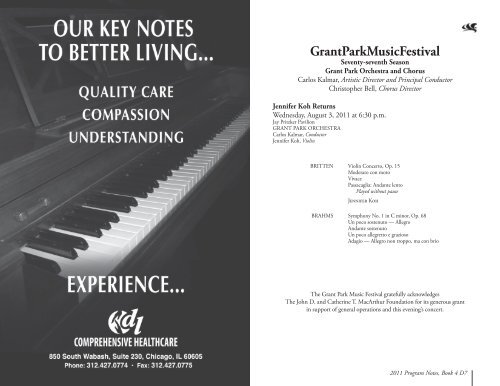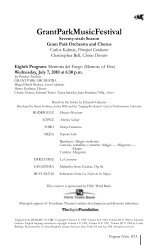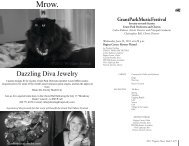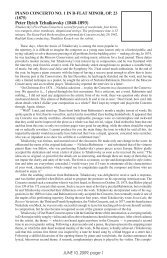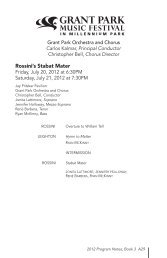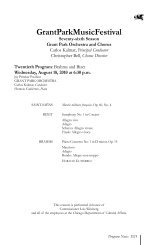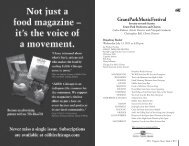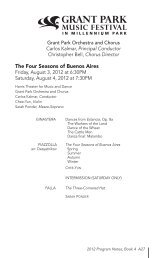Program Notes PDF - The Grant Park Music Festival
Program Notes PDF - The Grant Park Music Festival
Program Notes PDF - The Grant Park Music Festival
You also want an ePaper? Increase the reach of your titles
YUMPU automatically turns print PDFs into web optimized ePapers that Google loves.
<strong>Grant</strong><strong>Park</strong><strong>Music</strong><strong>Festival</strong><br />
Seventy-seventh Season<br />
<strong>Grant</strong> <strong>Park</strong> Orchestra and Chorus<br />
Carlos Kalmar, Artistic Director and Principal Conductor<br />
Christopher Bell, Chorus Director<br />
Jennifer Koh Returns<br />
Wednesday, August 3, 2011 at 6:30 p.m.<br />
Jay Pritzker Pavilion<br />
<strong>Grant</strong> <strong>Park</strong> orchestra<br />
Carlos Kalmar, Conductor<br />
Jennifer Koh, Violin<br />
BRITTEN Violin Concerto, Op. 15<br />
Moderato con moto<br />
Vivace<br />
Passacaglia: Andante lento<br />
Played without pause<br />
Jennifer Koh<br />
BRAHMS Symphony No. 1 in C minor, Op. 68<br />
Un poco sostenuto — Allegro<br />
Andante sostenuto<br />
Un poco allegretto e grazioso<br />
Adagio — Allegro non troppo, ma con brio<br />
<strong>The</strong> <strong>Grant</strong> <strong>Park</strong> <strong>Music</strong> <strong>Festival</strong> gratefully acknowledges<br />
<strong>The</strong> John D. and Catherine T. MacArthur Foundation for its generous grant<br />
in support of general operations and this evening’s concert.<br />
2011 <strong>Program</strong> <strong>Notes</strong>, Book 4 D7
GRANT PARK MUSIC FESTIVAL Wednesday, August 3, 2011 Wednesday, August 3, 2011 GRANT PARK MUSIC FESTIVAL<br />
Violinist Jennifer Koh has earned a wide reputation for bringing her<br />
probing intellectual acuity to contemporary and traditional repertoire in<br />
equal measure. Ms. Koh is committed to exploring connections between<br />
the pieces she plays. Accordingly, her programs often present rare and revealing<br />
juxtapositions, offering works by composers as divergent as Mozart<br />
and Ligeti, Schubert and Saariaho. Ms. Koh’s most recent recording<br />
for the Cedille label, Rhapsodic Musings, released in 2010, features solo<br />
violin works by 21st-century composers; the disc also includes a visual<br />
component — a dynamic interpretation of Esa-Pekka Salonen’s Lachen<br />
Verlernt for solo violin by filmmaker Tal Rosner, presented by the 2010<br />
Tribeca Film <strong>Festival</strong> in the “Shorts: Experimental Collisions” category. Ms. Koh records regularly<br />
for the Chicago-based Cedille label, and, in addition to Rhapsodic Musings, she recently released the<br />
Grammy-nominated recording String Poetic. Her other Cedille recordings include an acclaimed CD<br />
devoted to the Schumann violin sonatas plus music by such varied composers as Bach, Schubert,<br />
Szymanowski, Martinu, Schoenberg and jazz great Ornette Coleman, and Portraits, a disc featuring<br />
violin concertos by Szymanowski and Martinu recorded with the <strong>Grant</strong> <strong>Park</strong> Orchestra conducted<br />
by Carlos Kalmar. A prolific recitalist, she appears frequently at major music venues and festivals,<br />
including Carnegie Hall, Kennedy Center, Kimmel Center in Philadelphia, Marlboro, Wolf Trap,<br />
Spoleto and <strong>Festival</strong> International de Lanaudiere in Canada. Born in Chicago of Korean parents,<br />
Jennifer Koh currently resides in New York City. She is a graduate of Oberlin College and an<br />
alumna of the Curtis Institute, where she worked with Jaime Laredo and Felix Galimir. Ms. Koh is<br />
grateful to her private sponsor for the generous loan of the 1727 Ex Grumiaux Ex General DuPont<br />
Stradivari she uses in performance. Violinist Jennifer Koh returns to the <strong>Grant</strong> <strong>Park</strong> <strong>Music</strong> <strong>Festival</strong><br />
for the first time since 2005. Her two most recent performances with the <strong>Grant</strong> <strong>Park</strong> <strong>Music</strong> <strong>Festival</strong><br />
resulted in the release of a CD, Jennifer Koh Portraits, featuring Martinu’s Violin Concerto No. 2,<br />
Bartok’s Two Portraits and Szymanowski’s Violin Concerto No 1.<br />
Violin Concerto, Op. 15 (1938-1939)<br />
Benjamin Britten (1913-1976)<br />
Britten’s Violin Concerto is scored for piccolo, two flutes, oboe, English horn,<br />
two clarinets, two bassoons, four horns, three trumpets, three trombones, tuba,<br />
timpani, percussion, harp and strings. <strong>The</strong> performance time is 32 minutes.<br />
This is the first performance of this Concerto by the <strong>Grant</strong> <strong>Park</strong> Orchestra.<br />
Benjamin Britten was 26 in 1939, and much unsettled about his life.<br />
Though he had already produced fourteen works important enough to be<br />
given opus numbers and a large additional amount of songs, chamber music, choral works and film<br />
and theater scores, he felt his career was stymied both by an innate conservatism among the British<br />
music public and by the increasingly assured threat of war in Europe. Additionally troubling was his<br />
proclaimed pacificism in a nation girding itself for battle. In January 1939, his friends poet W.H.<br />
Auden and novelist Christopher Isherwood left for America in search of creative stimulation and<br />
freedom from what Auden called the English artist’s feeling of being “essentially lonely, twisted in<br />
dying roots.” With the promise of a performance of his Variations on a <strong>The</strong>me of Frank Bridge by the<br />
New York Philharmonic in August and the prospect (never realized) of writing a score for a Hollywood<br />
film about King Arthur, Britten decided to follow Auden, and in May he left England with<br />
his life-long companion, the tenor Peter Pears, intent on becoming a citizen of the United States.<br />
Since Britten and Pears planned on taking up a permanent working status, they skirted immigration<br />
regulations by entering the United States through Canada, where they became “legal<br />
British immigrants” and spent several pleasant weeks in Toronto establishing contact with the representatives<br />
in that city of the composer’s publisher, Boosey & Hawkes. (In December 1939, Britten<br />
composed the lighthearted Canadian Carnival for orchestra as a souvenir of his visit.) <strong>The</strong>y arrived<br />
in New York in late June, and were invited “for a weekend” by William and Elizabeth Mayer to<br />
their home in Amityville, Long Island — except for short trips away and a brief, rowdy period with<br />
a houseful of artists headed by Auden in Brooklyn, it was to be their principal residence until they<br />
returned to England almost three years later. Despite frequent bouts of depression and ill health,<br />
Britten composed freely in America, producing such important scores as the Violin Concerto, Les<br />
Illuminations, Michelangelo Sonnets, Sinfonia da Requiem, Ceremony of Carols and the operetta Paul<br />
Bunyan. (<strong>The</strong> Hollywood film project never materialized.)<br />
In August 1938, several months before he left for America, Britten appeared as soloist in the<br />
premiere of his Piano Concerto at a Promenade Concert in London. <strong>The</strong> venture went well enough<br />
that he began a concerto for violin three months later, and carried the sketches with him when<br />
he sailed for Canada in May 1939. He worked on the Violin Concerto in Toronto over the next<br />
several weeks and at his home on Long Island during the summer, and finished it while vacationing<br />
in the Quebec town of St. Jovite in September. He submitted the score for consideration to Jascha<br />
Heifetz, who was then preparing for the December premiere in Cleveland of the Violin Concerto<br />
that William Walton had just written for him, but the famed violinist rejected Britten’s Concerto as<br />
unplayable (though without specifying whether his judgment arose from technical, contractual or<br />
political considerations). Britten then contacted the Spanish virtuoso Antonio Brosa, an old friend<br />
and fellow student of the English composer Frank Bridge with whom he had given the premiere of<br />
his Suite for Violin and Piano (Op. 6) on a BBC broadcast in March 1936. Brosa, like Britten, had<br />
settled in the United States with war looming in Europe, and he agreed to give the Concerto’s premiere<br />
on March 28, 1940 with the New York Philharmonic and its music director, John Barbirolli,<br />
another English musician then working in America. <strong>The</strong> reviews of the premiere were mixed —<br />
“pretty violent: either pro or con,” Britten remembered — but among those who heard a distinctive<br />
voice in this music was the American composer Elliott Carter, who wrote that “nobody could fail to<br />
be impressed by the remarkable gifts of the composer, the size and ambition of his talent.”<br />
<strong>The</strong> Concerto’s broad, darkly noble first movement begins with a succinct, open-interval motive<br />
in the timpani that recurs throughout as a motto. Above the bassoon’s muttering repetitions of<br />
the motto, the solo violin presents the main theme, a melody made from a series of short, smooth,<br />
D8 2011 <strong>Program</strong> <strong>Notes</strong>, Book 4<br />
2011 <strong>Program</strong> <strong>Notes</strong>, Book 4 D9
Wednesday, August 3, 2011<br />
GRANT PARK MUSIC FESTIVAL<br />
mostly descending phrases. <strong>The</strong> orchestra takes over the main theme to provide a transition to<br />
the second subject, which is constructed from extensive elaborations of the rhythms and intervals<br />
inherent in the motto. A climax is built from this material in the development section before the<br />
recapitulation begins with roles reversed from the exposition: the upper strings play the main theme<br />
while the soloist hammers out aggressive permutations of the motto. <strong>The</strong> second subject is omitted<br />
in the recapitulation, but the violin reclaims the main theme in the coda, intoning it musingly<br />
above a sparse accompaniment of timpani, harp and plucked strings. <strong>The</strong> second movement is<br />
a driving, virtuosic, slightly sinister scherzo for which the more relaxed central section provides<br />
formal and expressive contrast. A brilliant cadenza that recalls the timpani motto and the main<br />
theme from the first movement serves as a bridge to the finale. <strong>The</strong> somber closing movement is<br />
a passacaglia, a formal technique using a series of variations on a short, recurring melody that was<br />
highly favored by Baroque composers but which fell into disuse with the changed requirements of<br />
the music of the Classical era. Britten fitted this passacaglia with nine variations on a stern scalar<br />
melody, and gave the music a serious emotional cast that seems to have reflected his sorrow over<br />
the horrors of the Spanish Civil War, which reached its bloody climax when he was completing<br />
the Concerto. “It is at times like these,” he said, “that work is so important — so that people can<br />
think of other things than blowing each other up! ... I try not to listen to the radio more than I can<br />
help.” Though Benjamin Britten was only 27 when he composed his Violin Concerto, the work<br />
shows that he had already become a master of reflecting the human condition in music of technical<br />
mastery and emotional depth.<br />
Symphony No. 1 in C minor, Op. 68 (1855-1876)<br />
Johannes Brahms (1833-1897)<br />
Brahms’ Symphony No. 1 is scored for pairs of woodwinds plus contrabassoon,<br />
four horns, two trumpets, three trombones, timpani and strings. <strong>The</strong> performance<br />
time is 45 minutes. <strong>The</strong> <strong>Grant</strong> <strong>Park</strong> Orchestra first performed this Symphony<br />
on August 15, 1937, with Hans Lange conducting.<br />
Brahms, while not as breathtakingly precocious as Mozart, Mendelssohn<br />
or Schubert, got a reasonably early start on his musical career: he had produced<br />
several piano works (including two large sonatas) and a goodly number of songs by the age of<br />
nineteen. In 1853, when Brahms was only twenty, Robert Schumann wrote an article for the widely<br />
distributed Neue Zeitschrift für Musik, his first contribution to that journal in a decade, hailing<br />
Brahms as the savior of German music, the rightful heir to the mantle of Beethoven. Brahms was<br />
extremely proud of Schumann’s advocacy and he displayed the journal with great joy to his friends<br />
and family when he returned to his humble Hamburg neighborhood after visiting Schumann in<br />
Düsseldorf, but there was the other side of Schumann’s assessment as well, that which placed an<br />
immense burden on Brahms’ shoulders.<br />
Brahms was acutely aware of the deeply rooted traditions of German music extending back not<br />
just to Beethoven, but even beyond him to Bach and Schütz and Lassus. His knowledge of Bach was<br />
so thorough, for example, that he was asked to join the editorial board of the first complete edition<br />
of the works of that Baroque master. He knew that, having been heralded by Schumann, his compositions,<br />
especially a symphony, would have to measure up to the standards set by his forebears.<br />
At first he doubted that he was even able to write a symphony, feeling that Beethoven had nearly<br />
expended all the potential of that form, leaving nothing for future generations. “You have no idea,”<br />
Brahms lamented, “how it feels to hear behind you the tramp of a giant like Beethoven.”<br />
Encouraged by Schumann to undertake a symphony (“If one only makes the beginning, then<br />
the end comes of itself,” he cajoled), Brahms made some attempts in 1854, but was unsatisfied<br />
with the symphonic potential of the sketches, and he diverted them into the First Piano Concerto<br />
and the German Requiem. He began again a year later, perhaps influenced by a performance of<br />
Schumann’s Manfred, and set down a first movement, but this music he kept to himself, and even<br />
his closest friends knew of no more than the existence of the manuscript. Seven years passed before<br />
2011 <strong>Program</strong> <strong>Notes</strong>, Book 4 D11
Wednesday, August 3, 2011<br />
GRANT PARK MUSIC FESTIVAL<br />
he sent this movement to Clara, Schumann’s widow, to seek her opinion. With only a few reservations,<br />
she was pleased with this C minor sketch, and encouraged Brahms to hurry on and finish the<br />
rest so that it could be performed. Brahms, however, was not to be rushed. Eager inquiries from<br />
conductors in 1863, 1864 and 1866 went unanswered. It was not until 1870 that he hinted about<br />
any progress at all beyond the first movement.<br />
<strong>The</strong> success of the superb Haydn Variations for orchestra of 1873 seemed to convince Brahms<br />
that he could complete his initial symphony, and in the summer of 1874 he began two years of labor<br />
— revising, correcting, perfecting — before he signed and dated the score of the First Symphony in<br />
September 1876. He was at work right up to the premiere, making alterations after each rehearsal.<br />
<strong>The</strong> C minor Symphony met with a good but not overwhelming reception. It was considered by<br />
some to be stern and ascetic, lacking in melody (!). One critic suggested posting signs in concert<br />
halls warning: “Exit in case of Brahms.” But Brahms’ vision was greater than that of his audiences,<br />
and some time was needed by listeners to absorb the manifold beauties of this work. It is a serious<br />
and important essay (“Composing a symphony is no laughing matter,” according to Brahms), one<br />
that revitalized the symphonic sonata form of Beethoven and combined it with the full contrapuntal<br />
resources of Bach, a worthy successor to the traditions Brahms revered. In the years since its<br />
premiere, it has become the most performed of Brahms’ symphonies and one of the most cherished<br />
pieces in the orchestral literature.<br />
<strong>The</strong> success and popularity of the First Symphony are richly deserved. It is a work of supreme<br />
technical accomplishment and profound emotion, of elaborate counterpoint and beautiful melody.<br />
Even to those who know its progress intimately, it reveals new marvels upon each hearing. <strong>The</strong> first<br />
movement begins with a slow introduction in 6/8 meter energized by the heart-beats of the timpani<br />
supporting the full orchestra. <strong>The</strong> violins announce the upward-bounding main theme in the faster<br />
tempo that launches a magnificent, seamless sonata form. <strong>The</strong> second movement starts with a<br />
placid, melancholy song led by the violins. After a mildly syncopated middle section, the bittersweet<br />
melody returns in a splendid scoring for oboe, horn and solo violin. <strong>The</strong> brief third movement, with<br />
its prevailing woodwind colors, is reminiscent of the pastoral serenity of Brahms’ earlier Serenades.<br />
<strong>The</strong> finale begins with an extended slow introduction based on several pregnant thematic ideas.<br />
<strong>The</strong> first, high in the violins, is a minor-mode transformation of what will become the main theme<br />
of the finale, but here broken off by an agitated pizzicato passage. A tense section of rushing scales<br />
is halted by a timpani roll leading to the call of the solo horn, a melody originally for Alphorn<br />
that Brahms collected while on vacation in Switzerland. <strong>The</strong> introduction concludes with a noble<br />
chorale intoned by trombones and bassoons, the former having been held in reserve throughout<br />
the entire Symphony just for this moment. <strong>The</strong> finale proper begins with a new tempo and one of<br />
the most famous themes in the repertory, a stirring hymn-like melody that resembles the finale of<br />
Beethoven’s “Choral” Symphony. (When a friend pointed out this affinity to Brahms he shot back,<br />
“Any fool can see that!”) <strong>The</strong> movement progresses in sonata form, but without a development section.<br />
<strong>The</strong> work closes with a majestic coda in the brilliant key of C major featuring the trombone<br />
chorale of the introduction in its full splendor.<br />
Of Brahms’ symphonies, and this one in particular, Lawrence Gilman wrote, “<strong>The</strong> essential<br />
fact to remember and to celebrate about Brahms is that he possessed not only the mechanisms of<br />
the grand style, but that he was able to exert it as a vehicle for ideas of authentic greatness, and he<br />
achieved this miracle with a continence, a sense of balance and proportion, an instinct for the larger<br />
contours as well as the finer adjustments of musical design, that were almost unerring.”<br />
©2011 Dr. Richard E. Rodda<br />
2011 <strong>Program</strong> <strong>Notes</strong>, Book 4 D13


